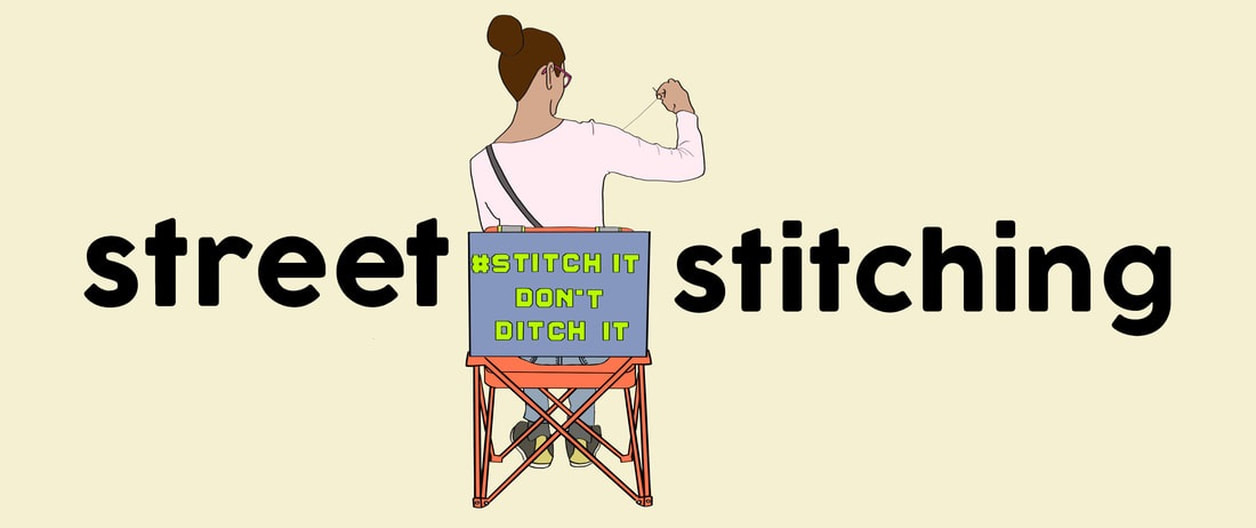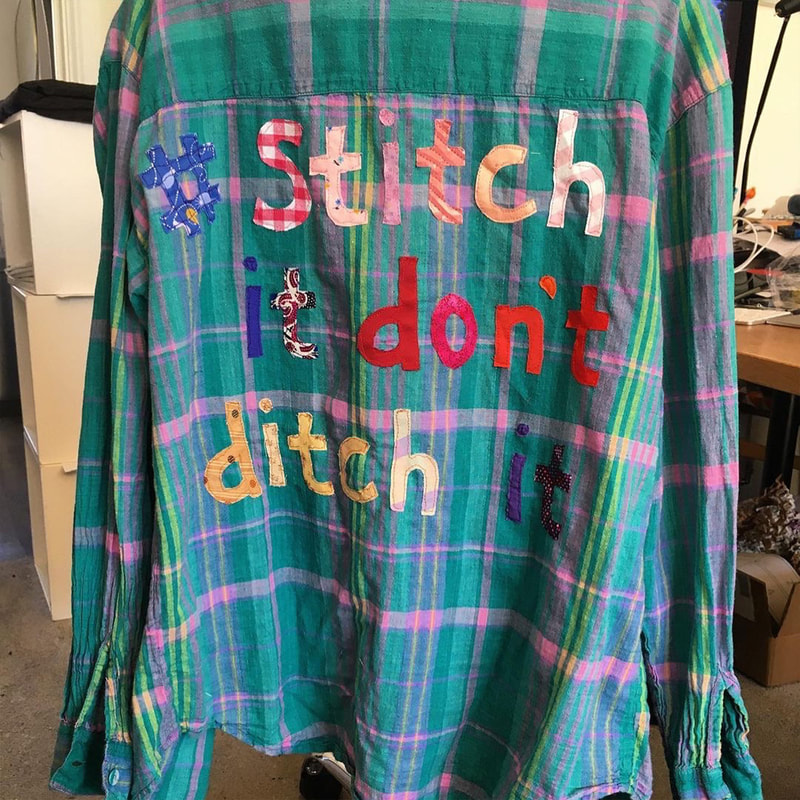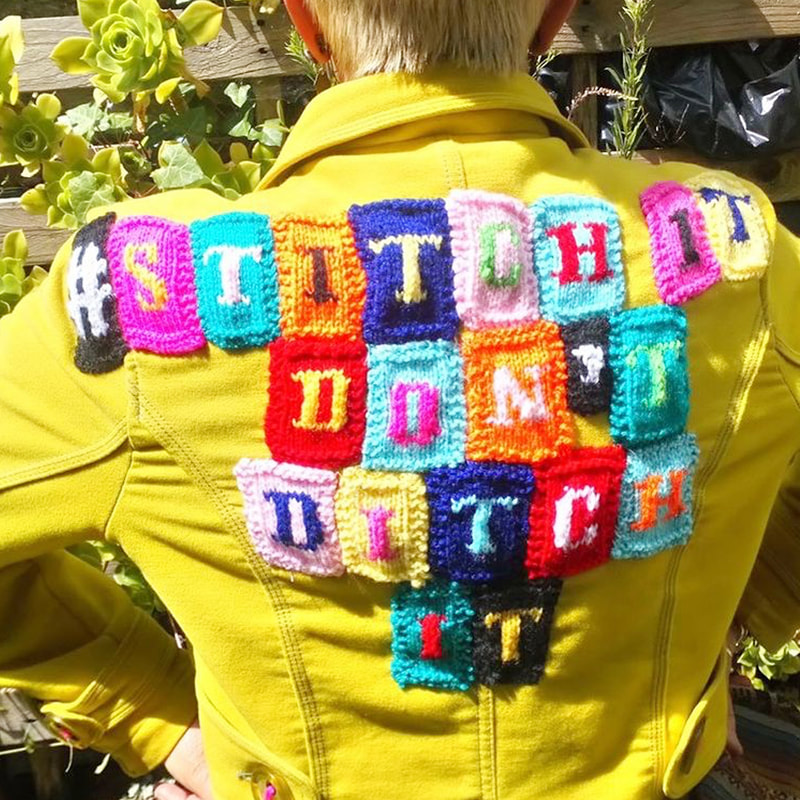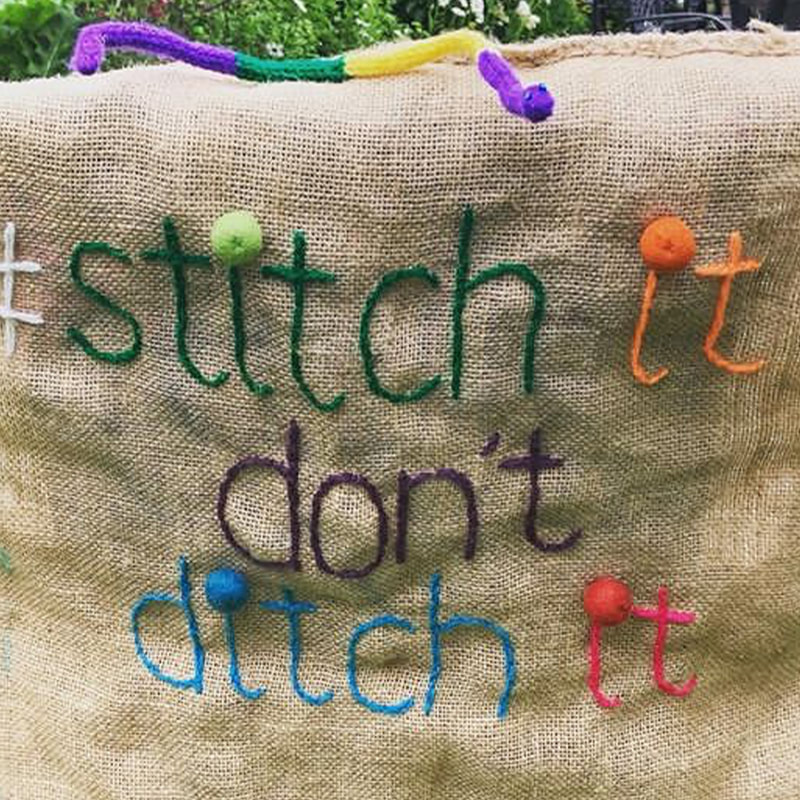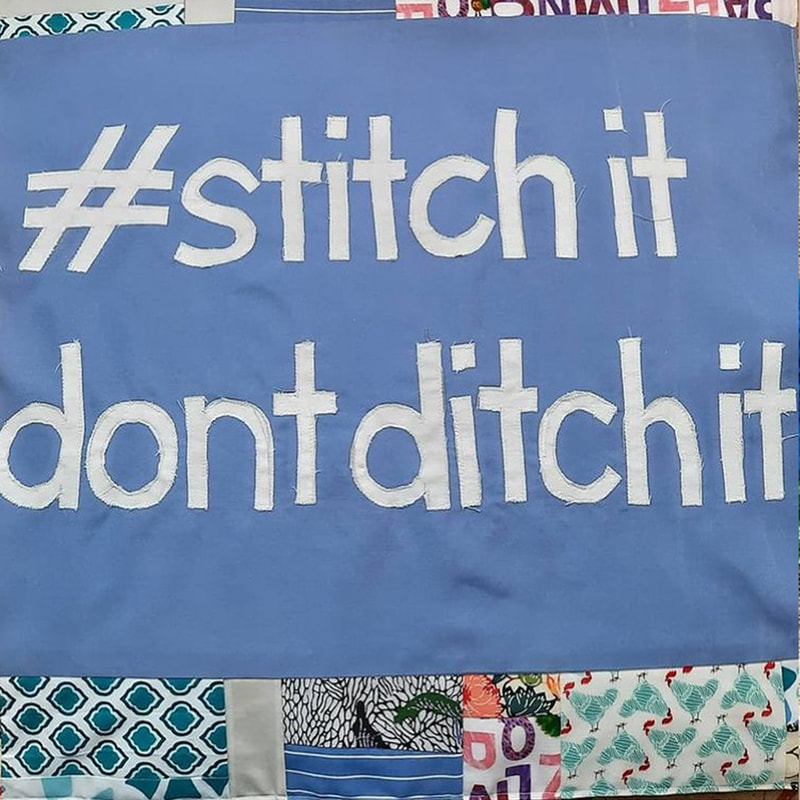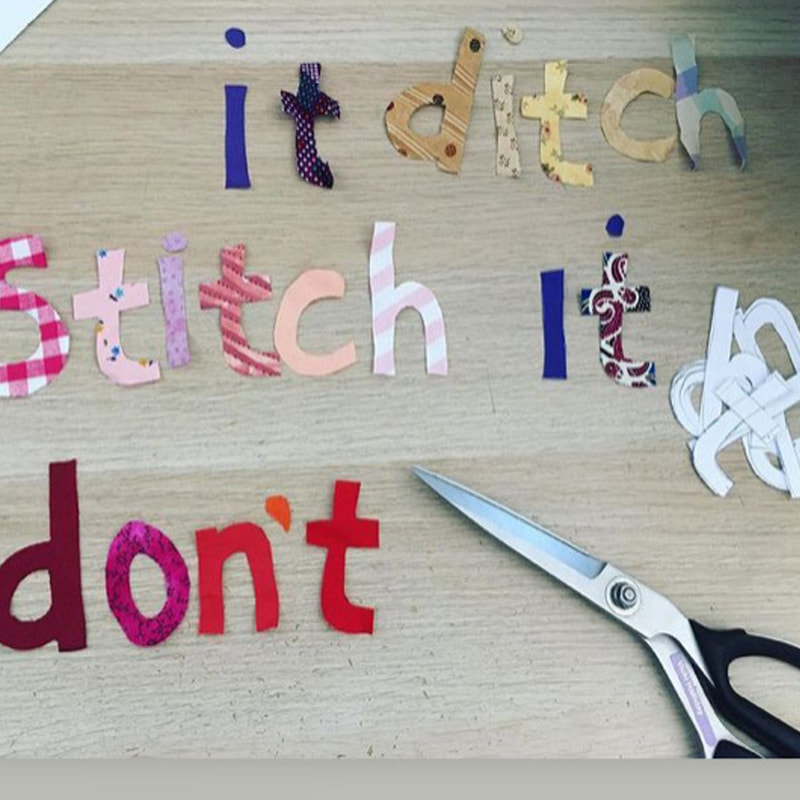Become a Line Maker
USEFUL BUMPH FOR ANYONE ORGANISING THIER OWN STREET STITCHING GROUP
Thank you for taking this Street Stitching idea to heart and for deciding to create your own #stitchitdontditchit event. To make sure your action chimes with all the others taking place,
there are a few rules to follow and and few things to bear in mind.
there are a few rules to follow and and few things to bear in mind.
|
WHAT IS STREET STITCHING?
Probably the first thing to say is that this isn’t a protest. And it's important we stay away from labels that suggest it is directly 'against’ anything. Particularly if we are speaking to the press / or any authority figures.. I’m calling it a positive action event. Or a happening. Or an encouragement. It places us in the arena of a public gathering more akin to an art event or creative theatre piece. Which I think suits this style of communication better than words that put us in a camp with actions like rallies, protests and sit-ins. A way of showing what we want to see more of rather than protesting about what we want to see less of. COVID
It’s a good idea to exaggerate our response to covid rules. Keep a gap of 2 metres between each sitter and also leave a few wider gaps every 10 sitters or so for wheelchairs, buggies and groups of shoppers to pass easily between us. Have a face mask to hand, and a little bottle of sanitiser. Make sure we can’t be moved on for not following distancing rules. THE STREET
Choose a street that is pedestrianised, free of street furniture and wide enough to allow you to keep a good distance from any shop fronts, doorways, traffic or cafe furniture. If there are cafe chairs and tables on the street, break the line of stitchers to give the public ample room to come and go so we don’t get any proprietors' backs up. We don’t want to effect their business Some shops own part of the pavement outside their premises. This is usually marked by small bronze bumps along the perimeter of their property. This is quite rare but just be mindful if you see them. SPEAKING WITH THE POLICE
There are excellent guidelines for what to do if the police approach you on the Extinction Rebellion (XR) website. And I really recommend you attend one of their online chats about it. You’ll find a calendar here: XR: Non-violent directs action training and know your rights training - https://extinctionrebellion.uk/act-now/resources/talks-and-trainings/directory/#nonviolent-direct-action-training But to summarise, they have some key messages about knowing your rights with the police. Here are a few: 1. No comment. You do not have to speak to the police at all. If they ask you questions like ‘Who is in charge?’ ‘What are you doing here?’ Anything chatty to try and obtain information, you can politely say no comment. 2. No personal details. You don’t have to give your name or anyone elses' name to the police unless you are actually being arrested. Which would be extremely unlikely! 3. No caution. Don’t sign or accept anything the police give you. If you accept a caution it’s an admission of guilt. 4. Under what power? If you’re asked to move you can ask them to explain what law they are using to enforce this, as they need a legal basis for their actions. You can write down or film what they say. Remember, any limitation they place on you must be: covered by law be necessary and proportionate be in the interests of national security or public safety be to prevent disorder or crime be to protect health or morals be to protect others’ rights and freedoms. So if you have these bolted down, they will find very little to make it necessary to interfere. It might be worth letting them know that the action is due to only last an hour. SPEAKING WITH THE PUBLIC
Although the aim is to say as little as possible, if members of the public approach us, then of course it’s good to speak with them. There is a large resource via Wakelet of free tutorials on simple repairs, visible and invisible mending, embellishments, embroidery stitches, how to use fabric from clothes that are beyond hope, and others. Also reasons why mending is so good for us and the planet. And a list of shops that have embraced the need to offer repair and up cycling. The QR code is available to print off from this website, or it even works if you take a photo of it on your phone.. Please share it with anyone joining you so every stitcher has a copy. (Maybe reinforce it or dare I say laminate it to keep it clean and dry.) This is so that curious shoppers can take a photo of the list and we don’t need to make wasteful flyers or leaflets. CALM
If we are heckled, smile sweetly and don’t engage. If anyone becomes argumentative, try not to enter into a heated debate but explain calmly that you have to finish mending your garment and can’t chat any more PHOTOS
Please take as many as you can. And specifically images of stitchers from the back clearly showing their #stitchitdontditchit chair banners. This image is like the logo for the movement, and the more we can repeat it, the stronger our message becomes. I wish all you all such luck!! And please get in touch if there are things you think should be added or amended. [email protected] x |
OUR RIGHTS
We are completely within our rights to stage a peaceful protest and Freedom of Assembly is a human right under article 11 of the European Convention of Human Rights. The gov.uk website spells this out so if you want to have a read yourself please do. It also states that stationary gatherings don’t need permission from the police and we do not need to inform them beforehand of our intentions. It is only if we are planning to march that they need to be notified in advance. There is also no rule that says we have to contact the council. I combed the internet for quite some time to find evidence of this and in the end spoke with two protest lawyers who confirmed this was the case. One said it was like trying to find guidelines on the right to wear jelly on your head. It doesn’t exist because no-one needs permission for it! However, this may not stop someone from the council coming to tell us we need to move on, even if it not strictly illegal. PUBLIC LAND
You should make sure the pavement you are on is public land and not a private mall or indoor shopping centre. These places will have their own security guards and they’ll have us out the door in 5 minutes flat! Most high streets are public. RISK ASSESSMENT
It’s a really good idea to visit the area before the day of the event and carry out a risk assessment. How much space does your group sitting at 2 metres apart take up? Are you blocking anything? Do you have to cross roads or cycle lanes. Picture it in your head and have a clear idea of where you are going to sit on the day. If the police are called they may ask if you have carried out an assessment. You don’t have to show it to them, but it would be good if you have it on you and the answer is yes. Check there are no markets or other events happening on the date you plan to stitch. We should not compete for space with market traders, street performers, coffee stands or anyone else who has booked to be there. And that will give the council / police an ideal excuse to move us. WHAT TO DO AND BRING ON THE DAY
Bring your own chairs so that you’re not sitting on the floor. (Sitting looks rather anti-social and provocative.) Form a single file crocodile of chairs spaced 2 metres apart all facing the same way. Make a chair banner with ‘#stitch it don’t ditch it’ and hang if from the back of your seat. This could be sewn, painted, hand written, cut from paper, stitched on a garment etc. - whatever you have time for and will enjoy making. This look will keep all our actions visually cohesive and dispenses with the need for other banners and placards that will tip the mood of the event towards a traditional protest which we want to avoid. Bring as little as possible with you. The aim is to look neat and uncluttered. So a bag for your garment you wish to stich, a needle and thread and not much else. Choose a bag you can store tidily under your chair or place over the back of it. Don’t bring bundles of clothes to mend. The event is only an hour long and one piece of clothing is enough. If we end up with all sorts of clobber around each seat it gives a disorganised appearance and may invite criticism about cluttering the walk way. If you love bright colours, please wear them. Anything that makes us look approachable, friendly and non-intimidating. And which allows us to stand out in photos. SILENCE For the hour we are there, it’s best if we don’t natter to eat other or walk to each other’s chairs to chat. My plan is to go straight to a park afterwards for a picnic, which will be a wonderful time to get to know each other better and discuss the event. During the hour itself, bare in mind that this is a performance piece and it will make a stronger impression if we stay still, quiet and absorbed in the task of mending. That in itself will have a big impact. There is something very unusual about seeing people in public engaged in a task that they usually only perform in their own homes. It’s like seeing someone wash their hair in public! The more self contained we appear the bigger the contrast we will have to the milling shoppers around us. And the more distinctive we will look in any photos taken by the press or which end up on social media. ANSWERING QUESTIONS
The most likely objection to our action will be from people who will say that they can’t afford not to shop at cheap outlets and this is a valid point. My response would be to say that we are not suggesting that people shouldn’t shop at fast fashion chains but that they should buy clothes with a conscious intent to hold onto them. To enter into a contract with their purchases if you like, to look after and care for them and extend their useful life as long as possible. The idea of Street Stitching came to me when I was listening to an interview with Orsola de Castro (founder of Fashion Revolution and author of Loved Clothes Last.) She was saying that the disposability of cheap clothes had been exacerbated by people who don’t approve of the industry dismissing the clothing as cheap tat. This has enhanced their reputation as badly made garments not fit for longevity. But quite often this is untrue. Many low priced items are made just as well as more expensive ones, but because it is so easy to replace them, much attire is thrown away long before it is necessary. Let's extol the pleasure of repair rather than denigrate the habit of replacing. Our relationship with our clothes is like any relationship - it becomes more satisfying meaningful and rewarding the longer it lasts. Mending isn’t a chore. It’s a mindful act of self soothing and relaxation. It promotes gratitude for what we have and a respect for how our garments are constructed. Our aim is to demonstrate that repairing something broken gives our brains a bigger dopamine hit that purchasing something new. Persuading people of the benefits of mending rather than making them feel defensive about their purchasing habits. |
